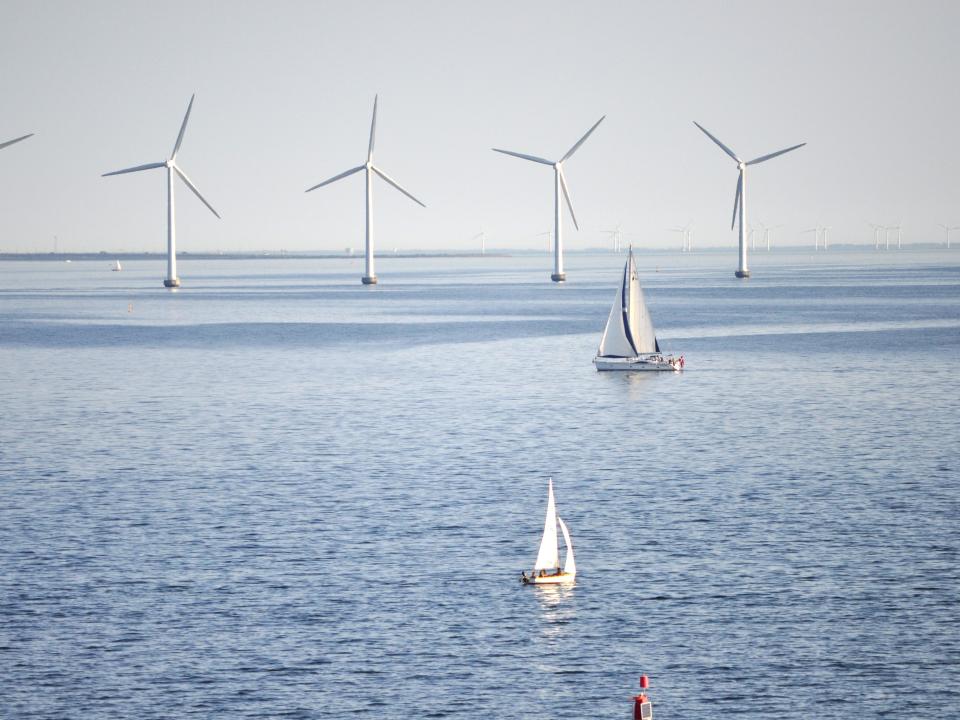Niquil, N., Scotti, M., Fofack-Garcia, R., Haraldsson, M., Thermes, M., Raoux, A., Le Loc’h F. & Mazé, C. (2021). The Merits of Loop Analysis for the Qualitative Modeling of Social-Ecological Systems in Presence of Offshore Wind Farms. Frontiers in Ecology and Evolution, 9, 35. https://doi.org/10.3389/fevo.2021.635798
L’apparition de parcs éoliennes offshore (OWF) sur les côtes et leur effet sur l’écosystème crée l’émergence d’un nouveau système socio-écologique (SES). Les interactions composant ce système sont de natures variées. Le changement concerne par exemple la composition du réseau trophique, à la base du fonctionnement de l’écosystème et de sa régulation. Les interactions entre acteurs humains forment la base du processus de décision de construire et développer de nouveaux parcs, les aspects sensibles pouvant jouer un rôle central. Toutes ces interactions peuvent être caractérisées par un travail de terrain, d’analyses de rapports et d’entretiens, pour construire les bases du réseau social. Cependant, la complexité repose essentiellement à l’interface entre société et écosystèmes. Dans cet articles d’opinion, nous présentons comment la modélisation qualitative et la ‘loop analysis’ permettent de s’intéresser aux challenges de la modélisation de ces SES uniques. L’intérêt est alors de joindre des interactions en unités différentes, et souvent non quantifiées. La modélisation du SES entier, autour du parc éolien, incluant les variables écologiques, socio-économiques et politiques, représente alors la solution idéale pour comprendre la complexité inhérente à ces systèmes complexes.
Contact : Nathalie Niquil, nathalie.niquil@unicaen.fr
Légende de l'illustration :
Des réseaux écologiques et sociaux au réseau socio-écologique et à son analyse par la ‘loop analysis’.
From ecological and social networks to predictions of SES dynamics with loop analysis. The ecological network (A) depicts trophic interactions in a hypothetical food web (arrows indicate energy flow direction). The social network (B) shows a toy model with biomass flows (black) and governmental (red) relationships together with conservation (green), marine protection (gray) and perception (blue). Animals in the social network represent the interface through which social actors directly interact with the ecosystem. A selection of variables from the ecological and social systems allows building the qualitative model of the SES (C) with positive (arrow-headed) and negative (circle-headed) relationships (i.e., digraph). The table of predictions (D) derived from the digraph describes expected changes in column variables triggered by positive press perturbations on row variables. The clustering along the rows and the columns accounts for similarities in the impacts generated and the responses, respectively. Codes: PH, phytoplankton; ZO, zooplankton; FI, forage fishes; MA, marine mammals; TR, trawl fisheries; CO, conservation; TO, tourism; OW, offshore wind farms. Copyright : © Niquil et al 2021, Frontiers in Marine Science.
L’apparition de parcs éoliennes offshore (OWF) sur les côtes et leur effet sur l’écosystème crée l’émergence d’un nouveau système socio-écologique (SES). Les interactions composant ce système sont de natures variées. Le changement concerne par exemple la composition du réseau trophique, à la base du fonctionnement de l’écosystème et de sa régulation. Les interactions entre acteurs humains forment la base du processus de décision de construire et développer de nouveaux parcs, les aspects sensibles pouvant jouer un rôle central. Toutes ces interactions peuvent être caractérisées par un travail de terrain, d’analyses de rapports et d’entretiens, pour construire les bases du réseau social. Cependant, la complexité repose essentiellement à l’interface entre société et écosystèmes. Dans cet articles d’opinion, nous présentons comment la modélisation qualitative et la ‘loop analysis’ permettent de s’intéresser aux challenges de la modélisation de ces SES uniques. L’intérêt est alors de joindre des interactions en unités différentes, et souvent non quantifiées. La modélisation du SES entier, autour du parc éolien, incluant les variables écologiques, socio-économiques et politiques, représente alors la solution idéale pour comprendre la complexité inhérente à ces systèmes complexes.
Contact : Nathalie Niquil, nathalie.niquil@unicaen.fr
Légende de l'illustration :
Des réseaux écologiques et sociaux au réseau socio-écologique et à son analyse par la ‘loop analysis’.
From ecological and social networks to predictions of SES dynamics with loop analysis. The ecological network (A) depicts trophic interactions in a hypothetical food web (arrows indicate energy flow direction). The social network (B) shows a toy model with biomass flows (black) and governmental (red) relationships together with conservation (green), marine protection (gray) and perception (blue). Animals in the social network represent the interface through which social actors directly interact with the ecosystem. A selection of variables from the ecological and social systems allows building the qualitative model of the SES (C) with positive (arrow-headed) and negative (circle-headed) relationships (i.e., digraph). The table of predictions (D) derived from the digraph describes expected changes in column variables triggered by positive press perturbations on row variables. The clustering along the rows and the columns accounts for similarities in the impacts generated and the responses, respectively. Codes: PH, phytoplankton; ZO, zooplankton; FI, forage fishes; MA, marine mammals; TR, trawl fisheries; CO, conservation; TO, tourism; OW, offshore wind farms. Copyright : © Niquil et al 2021, Frontiers in Marine Science.





